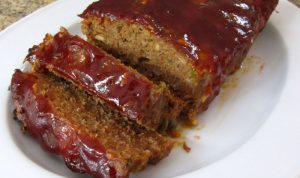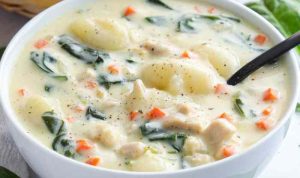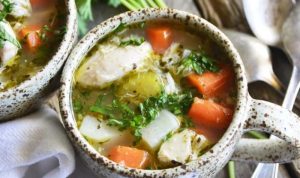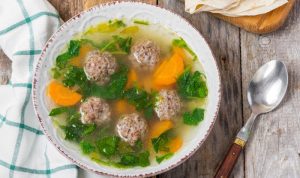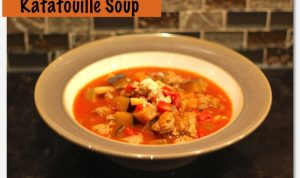Recipe Variations
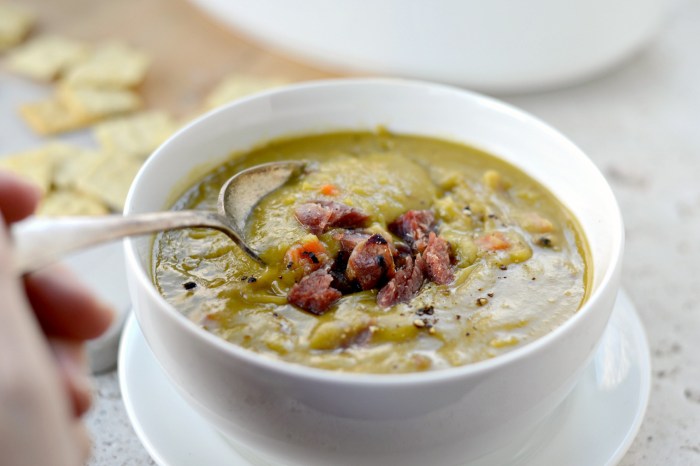
Source: simplyscratch.com
Recipes for split pea soup with ham – Split pea soup with ham offers a delightful canvas for culinary creativity. The fundamental recipe can be adapted to suit various skill levels and flavor preferences. Below, we explore three variations, ranging from simple to more complex, along with innovative flavor enhancements and an unconventional recipe incorporating unusual ingredients.
| Recipe Name | Difficulty | Ingredients | Instructions (Summary) |
|---|---|---|---|
| Easy Ham & Pea Soup | Easy | Split peas, ham bone, onion, carrots, celery, vegetable broth, salt, pepper | Sauté vegetables, add peas, broth, and ham bone. Simmer until peas are tender. |
| Ham & Pea Soup with Smoked Paprika & Sausage | Medium | Split peas, smoked ham hock, Italian sausage, onion, garlic, smoked paprika, bay leaf, vegetable broth, thyme | Brown sausage, sauté vegetables, add peas, broth, ham hock, and spices. Simmer until peas and sausage are cooked through. |
| Gourmet Ham & Pea Soup with Lemon & Tarragon | Hard | Dried split peas, smoked ham shank, leeks, celery root, fresh tarragon, lemon zest, dry white wine, vegetable broth, heavy cream | Sauté leeks and celery root, add peas, wine, broth, ham shank, and spices. Simmer until peas are tender, then stir in cream and lemon zest. |
Three unique flavor approaches include incorporating smoked ham for a deeper smoky flavor, using a blend of fresh herbs like thyme, rosemary, and sage for an earthy aroma, or experimenting with spice blends like a Cajun or Moroccan blend for a bolder taste profile.
An unusual recipe might incorporate roasted butternut squash and apples for sweetness and a contrasting texture, maintaining traditional elements like ham and split peas while adding a unique autumnal twist.
Cooking Methods and Techniques
The cooking method significantly impacts the final texture and flavor of split pea soup. Each method offers advantages and disadvantages.
- Stovetop: Offers precise temperature control, allowing for careful monitoring of the soup’s consistency. However, it requires more hands-on attention.
- Slow Cooker: Ideal for a hands-off approach, resulting in a tender, flavorful soup. However, it may not be suitable for recipes requiring quick cooking times or precise temperature control.
- Instant Pot: Provides a quick and convenient cooking method, resulting in a creamy, tender soup. However, it may require adjusting cooking times depending on the type of split peas used.
Proper preparation of split peas is crucial for optimal texture and flavor. Rinsing the peas removes excess starch and prevents cloudiness. Soaking the peas (optional, but recommended) softens them, reducing cooking time and improving texture.
Rendering ham involves slowly cooking the ham to extract its flavor into the soup. This can be achieved by simmering the ham bone or hock in the broth for an extended period, ensuring maximum flavor infusion.
Ingredient Substitutions and Adaptations
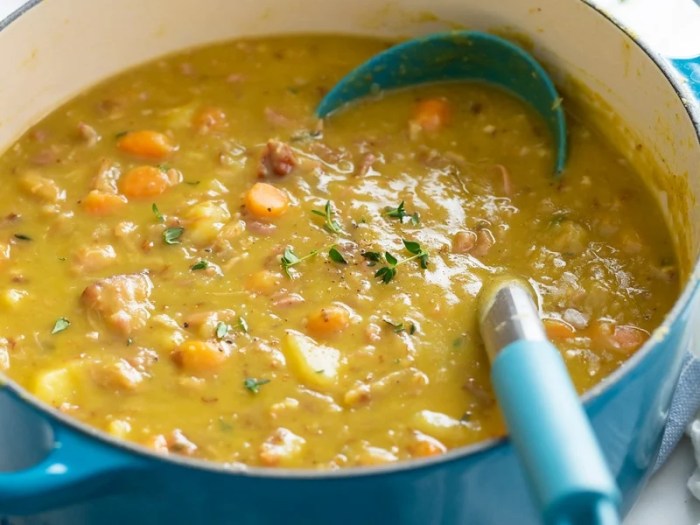
Source: thecozycook.com
Split pea soup is adaptable to dietary needs and ingredient availability. Several substitutions can be made without significantly compromising the taste.
Ham can be replaced with pancetta, smoked sausage, or even mushrooms for a vegetarian version. Vegetable broth can substitute chicken broth, and other types of legumes, like lentils or chickpeas, can be used in place of split peas, though this will alter the final texture and flavor.
A vegetarian variation could use smoked tofu or hearty mushrooms for a savory depth of flavor, alongside vegetable broth and a robust blend of herbs and spices.
Using different types of split peas—green, yellow, or brown—will affect the soup’s color, texture, and taste. Green split peas are commonly used and result in a creamy texture, while yellow split peas produce a slightly sweeter flavor.
Serving Suggestions and Presentation
Elevating the presentation of split pea soup enhances the dining experience. Simple garnishes and creative serving methods can transform this classic dish.
- Garnish with fresh parsley or chives.
- Serve with crusty bread for dipping.
- Add a dollop of crème fraîche or sour cream.
- Top with crispy fried onions.
- Serve in individual bread bowls for a rustic presentation.
Visually appealing presentation involves serving the soup in a warm bowl, garnished strategically. A swirl of crème fraîche, a sprinkle of fresh herbs, and a few croutons can create an elegant look. Using a contrasting color bowl can also enhance the visual appeal.
Leftover split pea soup can be repurposed into hearty fritters, a creamy soup base for pasta, or a filling for savory hand pies.
Nutritional Information and Health Aspects: Recipes For Split Pea Soup With Ham
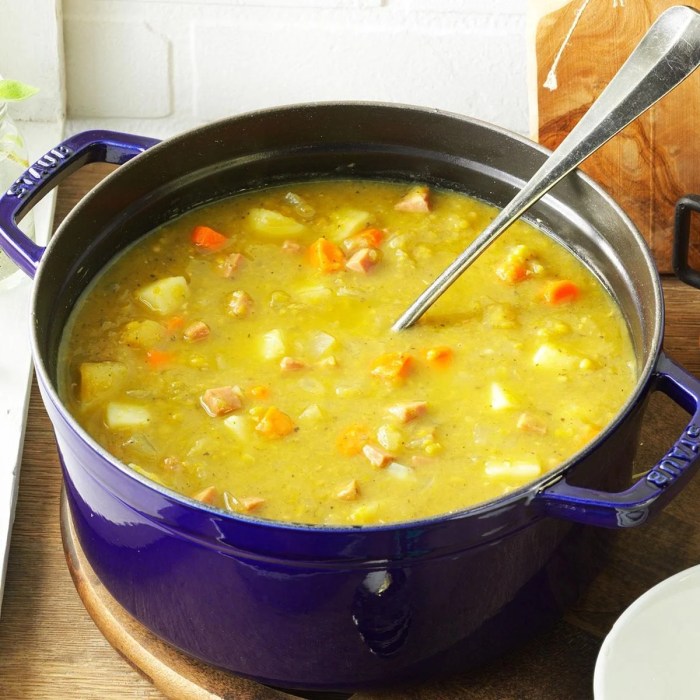
Source: tmbi.com
Split pea soup with ham provides a balanced meal with various nutritional benefits. However, the nutritional content varies depending on the specific ingredients and portion size.
| Nutrient | Amount per Serving (Approximate) | Percentage of Daily Value (Approximate) | Notes |
|---|---|---|---|
| Calories | 250-300 | 12-15% | Varies depending on ingredients and portion size. |
| Protein | 15-20g | 30-40% | Good source of plant-based protein. |
| Fat | 5-10g | 8-16% | Mostly from the ham. |
| Fiber | 10-15g | 40-60% | Excellent source of dietary fiber. |
Regular consumption of split pea soup can contribute to improved digestive health due to its high fiber content. However, those with high sodium intake should be mindful of the sodium content from the ham and broth. Compared to lentil soup, it offers similar fiber and protein content but may have higher fat content due to the ham. Compared to chicken noodle soup, it offers more fiber and plant-based protein but less readily available protein.
Historical and Cultural Context
Split pea soup with ham boasts a rich history, evolving over centuries across various cultures. Its origins are somewhat obscure, but its presence in various culinary traditions speaks to its enduring appeal.
In many Western cultures, split pea soup with ham is a staple comfort food, often associated with colder months and hearty meals. Variations exist across different regions, reflecting local ingredients and culinary preferences. For example, some recipes incorporate additional vegetables, spices, or herbs to reflect regional tastes.
Comparing traditional recipes reveals diverse approaches to preparation and flavor profiles. Some cultures may emphasize the use of specific types of ham or split peas, while others might incorporate unique spices or herbs to create a distinctive taste. This variation highlights the adaptability of the dish and its integration into diverse culinary landscapes.
Detailed FAQs
Can I use bone-in ham?
Yes, bone-in ham adds extra depth of flavor. Ensure you remove the bone before serving.
How long can I store leftover soup?
Store leftover soup in an airtight container in the refrigerator for up to 3-4 days.
Can I freeze split pea soup?
Yes, split pea soup freezes well. Allow it to cool completely before freezing in airtight containers for up to 2-3 months.
What are some good vegetarian alternatives to ham?
Smoked tofu, mushrooms, or a combination of vegetables like carrots and celery can provide savory depth in a vegetarian version.

